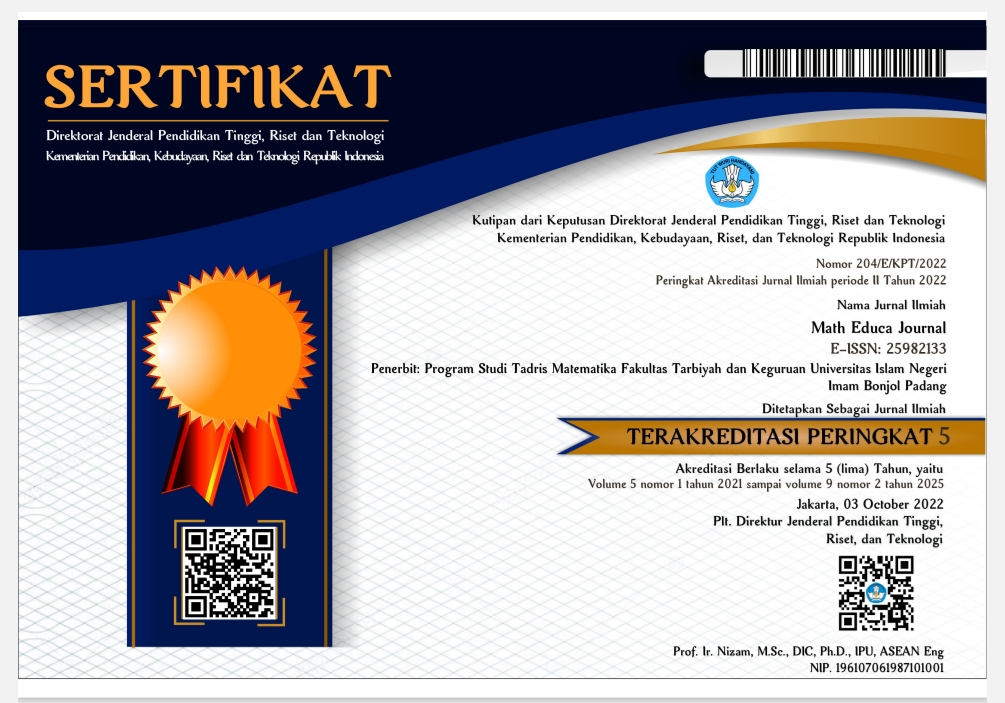PENGEMBANGAN LEMBAR KERJA PESERTA DIDIK BERBASIS CONTEXTUAL TEACHING AND LEARNING PADA MATERI HIMPUNAN KELAS VII SMPN 2 KUBUNG
Yulia Yulia, Gusniarti Gusniarti
Abstract
One of the problems in the world of education was the limited teaching materials that can help students enrich their experience, build students 'knowledge and support students' thinking skills to construct their own understanding in solving mathematical problems. One way that can be done to complement the shortcomings of teaching materials is to design an LKPD. LKPD is made using the CTL approach. Based on this, a CTL-based student worksheet (LKPD) was developed on set material for class VII students. This study aims to 1) produce CTL based LKPD that meets valid criteria 2) produce CTL based LKPD that meets practical criteria and 3) produces CTL based LKPD that meets the effective criteria. This is a development research with 4-D models. consists of four stages of development that is define, design, develop and disseminate. This research is only up to the stage of define, design and develop. Define’s stage consists of : a) front end analysis b) student analysis c) concept analysis d) task analysis. Design’s stage consists of : a) LKPD design b) instrument design and validation of instrument penilain module. Develop’s stage consists of : a) the stage of validity b) the stage of practicability an c) the stage of effectiveness. The results of this study indicate that based on the validator's assessment, The developed LKPD meets very valid criteria with an average of 89,14%. Based on the results of filling the practical questionnaire for educators, practical questionnaire for students and interviews with students showed that LKPD which was developed very practically was used in the mathematics learning of set material with an average of 88,20% by educators and 84,20% by students. Based on the results of the analysis of learning outcomes obtained the average value of the pre test is 59,9655 and the post test average value was 79,3793, then carried out the hypothesis with the t-test. From the calculation results obtained 5,0493 and thus with a confidence level of 95%. This shows that the hypothesis is accepted, meaning that the mathematical connection ability of students after using LKPD is better than the students’ mathematical connection ability before using LKPD so that it can be concluded that CTL based LKPD is effectively used
Keywords
Development, LKPD, Contextual Teaching and Learning (CTL), 4-D models

DOI:
https://doi.org/10.15548/mej.v3i2.882

Abstract views : 538 times

PDF : 494 times
References
Departemen Pendidikan Nasional. 2003. Standar Kompetensi Mata Pelajaran Matematika SMP & MTs Jakarta: Pusat Kurikulum, Balitbang Depdiknas
Riduwan.2010. Belajar Mudah Penelitian untuk Guru, Karyawan, dan Peneliti Pemula. Bandung: Alfabeta.
.2012. Belajar Mudah Penelitian untuk Guru, Karyawan, dan Peneliti Pemula. Bandung: Alfabeta.
Sanjaya, Wina. 2013. Strategi Pembelajaran (Orientasi Standar Proses Pendidikan). Jakarta: Kencana.
Sepriyanti, Nana. 2016. Pembelajaran Kalkulus Kontekstual (Suatu Modifikasi Model). Jakarta: Rajawali Pers.
Sepriyanti, Nana, dkk. 2017. Calculus Based On Contextual Teaching Model To Cultivate Student’s Activity , Interest And Mathematical Connection Ability. International Journal Of Scientific & Technologi Research (IJSTR). Vol.6, No.10.
Sudjana, Nana. 2005. Dasar-dasar Proses Belajar Mengajar. Bandung: Sinar Baru.
Trianto. 2010. Mendesain model Pembelajaran Inovatif Progrresif. Jakarta Kencana Prenada Media Group.
Trianto. 2014. Model Pembelajaran Terpadu: Konsep, Strategi, dan Implementasinya dalam Kurikulum Tingkat Satuan Pendidikan (KTSP). Jakarta: .Bum Aksara.
Refbacks
- There are currently no refbacks.

This work is licensed under a
Creative Commons Attribution-NonCommercial-ShareAlike 4.0 International License.
The Journal Space of the Mathematics Education Department
Faculty of Education and Teacher Training
State Islamic University of Imam Bonjol Padang
Email: mej.uinibpadang@gmail.com

Math Educa Journal is licensed under a Lisensi Creative Commons Atribusi-NonKomersial 4.0 Internasional.
Based on a work at https://ejournal.uinib.ac.id/jurnal/index.php/matheduca.
All rights reserved p-ISSN: 2580-6726 | e-ISSN: 2598-2133






